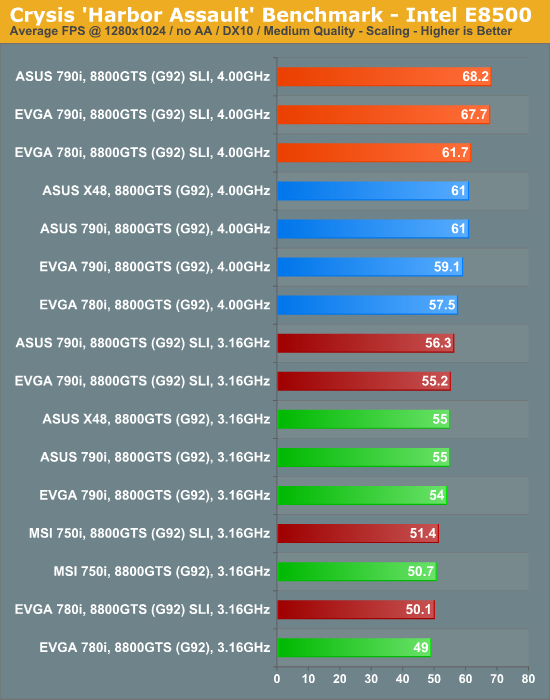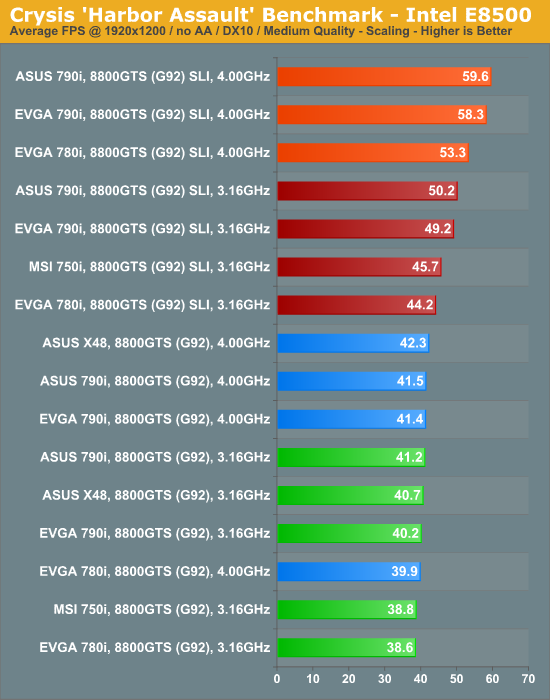ASUS Striker II Extreme: Mucho Bang, Mucho Bucks
by Kris Boughton on April 11, 2008 7:00 AM EST- Posted in
- Motherboards
Game Testing - Crysis
A favorite action title among today's gamers is without a doubt Crysis from EA Games. The trouble is that building or buying a system capable of running Crysis at acceptable frame rates using higher resolutions with all the eye candy turned on is next to impossible. SLI scaling, and Crysis performance in general, has improved lately, thanks to a few of the more recent non-WHQL ForceWare driver releases from NVIDIA, but it's still not quite up to speed as far we're concerned. Perhaps the next generation of GPUs will address this problem head-on.

Assuming you game at 1280x1024, an Intel E8500 and even a single 8800GTS 512MB (G92) graphics card is more than capable of rendering Crysis at average frame rates around 50FPS and above. Unfortunately, gaming at this lower resolution is not always the norm and certainly leaves much to be desired when compared to the amazing image displayed on a larger 24" flat panel LCD.
This round of results seems to suggest that Crysis is somewhat sensitive to memory performance and memory access latencies, at least at lower resolutions. The EVGA 780i reference board and MSI PN7 SLI Platinum, both of which use DDR2, trail all other DDR3 boards, even with SLI enabled. We considered the possibility that the older PCI-e 1.x technology used on these boards was the bottleneck (remember, 780i's PCI-e 2.0 support comes from a non-native bridge chip) but quickly dismissed this idea - it is far more probable that either the CPU or the memory subsystems are the limiting factors, especially at this low resolution.
Interesting to note is that if you do plan to play Crysis at this lower resolution you may be better off overclocking your CPU than buying a second graphics card, given the choice between the two. Even better, spend the money you set aside for that second graphics card on a new 790i or X48 motherboard - our test results show these two top-end chipsets (using DDR3) in single-card configurations keeping up with 780i with two graphics cards in SLI. Of course, if you already own a 780i-based motherboard chances are you are running SLI already. In that case moving up to a 790i-based motherboard will net you 15% higher frame rates using today's latest WHQL-approved ForceWare drivers.

Performance scaling with Crysis at 1920x1200 is an entirely different ballgame - the bottleneck is no longer the CPU and memory subsystems as evident by the non-existent frame rate improvements when overclocking our E8500 from the stock 3.16GHz to 4.00GHz. In fact, SLI does little to help the situation when installed in 750i- or 780i-based motherboards. The EVGA reference 790i board and the ASUS Striker II Extreme demonstrate they are more than capable of handling the load when configured properly.

Even with the additional processing power provided by two more cores, the EVGA 780i trails all others when it comes to average frame rate. This is more evidence that tends to support our earlier assumption that Crysis is sensitive to memory bandwidth at lower resolutions. Moreover, the lack of improvement when compared to the dual-core results above clearly indicates that Crysis is unwilling to make efficient use of more than two cores. If playing this game is the purpose of your next build your money will be better spent on motherboard and DDR3 memory upgrades rather than the latest quad-core CPU.

Once again, our scores are limited by our graphics capabilities. The only thing that is going to improve these frame rates at this point is more powerful GPUs. Assuming Quad-SLI is optimized for this game, two 9800GX2 cards may provide us with the means to push nearly 60FPS on "High" settings - quite an achievement considering the ability of DirectX 10 shaders to bring nearly any graphics card to its knees.










23 Comments
View All Comments
takumsawsherman - Saturday, April 12, 2008 - link
But for $400, you only get Firewire 400. Is that like a key, or something? If we pay $800 for a board, will they finally feel as though they can afford to add Firewire800, as Gigabyte did on their $200 boards like 3 or 4 years ago?When they talk about adding firewire itself to a board, does it never occur to them that a faster variation has existed for 5 or 6 years now? How insulting.
Grandpa - Saturday, April 12, 2008 - link
It doesn't matter what the price, performance, make, or model. If the board is unstable I don't want it! I had an Abit board once with a VIA chipset. It corrupted data when large files were transferred between drives. Several BIOS updates later, with the performance down to a crawl, it still corrupted data. Because of that ugly bad memory, stability is number one important for me. So this review is very relevant to others like myself.Super Nade - Friday, April 11, 2008 - link
As far as I know, the capacitors you mention are made by Fujitsu's Media division (FP-Cap series), not Fairchild semiconductor. Fujitsu did try to gobble up Fairchild in the 80's, but the US government killed the deal. Apart from this, I am not aware of any connection between these two companies.Here is the link--> http://jp.fujitsu.com/group/fmd/en/services/capaci...">http://jp.fujitsu.com/group/fmd/en/services/capaci...
S-N
Stele - Saturday, April 12, 2008 - link
Super Nade's right. The vendor marking on the capacitors - which have been the same for almost all such solid electrolytic polymer caps used on Asus boards for some time now - is very much that of Fujitsu: a letter 'F' in Courier-esque font between two horizontal lines.Interestingly - and confusingly - however, once upon a time this logo was indeed that of Fairchild Semiconductor... the deal that almost happened in the 80s may have something to do with Fujitsu's current use of the said logo. Either way, Faichild Semi have long since changed to their current logo (a stylised italic 'f') so today, any current/new electronic/semiconductor component carrying the F-between-bars logo is almost certainly a Fujitsu product.
jojo29 - Friday, April 11, 2008 - link
Just wondering how the Anandtech's Choice P5E3 Premium ( which i plan on buying) stacks up against this Striker? Any comments? Or did i miss something in the aricle as i was only able to skim through it, as im at work atm, and dontcoughwantcoughtogetcaughtbymybosscough...kjboughton - Friday, April 11, 2008 - link
We used one X48 motherboard in this review and it was the ASUS P5E3 Premium. Enjoy the full read when you make it home. ;)ImmortalZ - Friday, April 11, 2008 - link
You mention that overclocking the PCI-E bus provided tangible performance benefits on the EVGA board.Did you read about the rumblings around the net about some G92 based cards overclocking their GPU with the PCI-E bus? There are supposedly two clock sources for these type of cards - one on board and the other slaved to the PCI-E bus.
Are you sure that the performance improvement is not because of this anomaly?
CrystalBay - Friday, April 11, 2008 - link
Hi Kris, while UT3 does scale very well with multi-core. The game it self has no DX10 support as of yet. Hopefully EPIC will will enable it in a future update...Glenn - Friday, April 11, 2008 - link
All the benchies and comparisons are great, but how does it compare to a P35 board? A 965 or X38 board? I doubt you will convert those that already own an X48 and I (P35) have no point of reference within this article to see if I'm 5, 10 or 25% behind the preformance curve?Rolphus - Friday, April 11, 2008 - link
Interesting review... only one question though. Why use the 32-bit version of Crysis on Vista x64? Is there an issue with the 64-bit version that I don't know about?